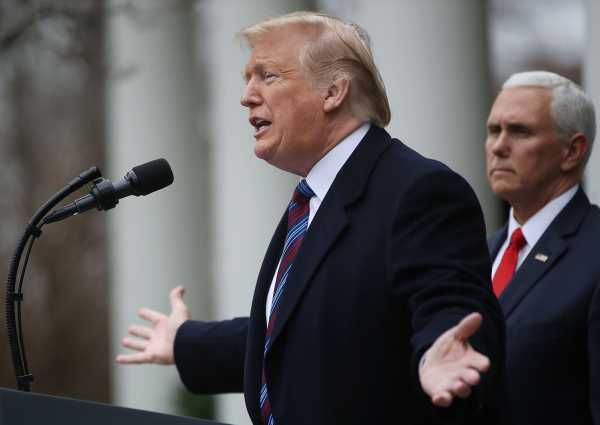
It’s day 20 of a partial government shutdown, and, according to Democrats, the latest talks ended in a literal “temper tantrum.”
President Donald Trump met with Democratic congressional leaders on Wednesday as part of the latest in shutdown negotiation meetings, only to slam a table and storm out once House Speaker Nancy Pelosi said she wouldn’t consider a wall, according to Senate Minority Leader Chuck Schumer. (House Republicans, meanwhile, characterized the meeting as a bit calmer.)
It’s not the first time Trump, Schumer, and Pelosi have come to verbal blows in the Oval Office in recent months. In December, a meeting between the trio about the border wall quickly devolved into a televised shouting match.
And not much has changed since: Trump still wants more than $5 billion for his border wall, and Democrats still don’t want to give it to him.
Their seemingly intractable standoff raises the question of whether this shutdown could wind up going on indefinitely — something Trump alluded to last week when he suggested it could continue for “years.”
Whether it does could ultimately depend on Senate Republicans, who have broadly sought to sidestep the conflict over the shutdown despite being the group who could end it.
As the shutdown continues to drag on, and neither Trump nor the Democrats give any indication of caving, the focus is increasingly on GOP members of the upper chamber, who overwhelmingly passed a spending bill without wall money in December and have the ability to stop this impasse if they want to.
“Republicans and Democrats will have to agree — not just one party,” said a spokesperson for Senate Majority Leader Mitch McConnell when asked about Senate Republicans’ ability to end a shutdown. McConnell has repeatedly put the onus on Democrats and Trump throughout shutdown talks, but as Slate’s William Saletan writes, that approach obscures the power of the Senate Republican majority to back Democrats’ existing spending bills and put pressure on the president.
Democrats are currently betting that if they can stick together on withholding votes for Trump’s border wall, the president will eventually be forced to cave — or risk telling Border Patrol, TSA officers, and every one of the 800,000 federal employees impacted by the shutdown that their paychecks will have to wait even longer. Trump is using a similar calculus and banking on public opinion to blame the Democrats, though he’s also raised a national emergency declaration as a way out.
Following a Wednesday meeting, Senate Republicans don’t seem like they’ll break with Trump anytime soon, though a handful expressed concerns about the president’s approach to the shutdown. What remains to be seen is just what, if anything, they’ll ultimately do about it.
Here are the demands from each side as they currently stand
The government is still shut down because of two disagreements.
One is a longstanding policy fight over border security, and the other is a negotiation over when to reopen the government. The impasse ultimately comes down to a difference in priorities. Trump wants a border wall before he will reopen the government. Democrats want Trump to reopen the government first, before they talk border security.
Democrats and Trump have been diametrically opposed on policy from the beginning: Trump wants $5.7 billion for his southern border wall, and Democrats say wall money is an absolute no-go — something they’ve emphasized since Trump took office.
Democrats have made this position very clear. When Trump asked Democratic leaders Wednesday whether they’d hypothetically agree to wall funding if he reopened the government first, Pelosi said no. (That’s when Schumer said Trump stormed out of the room.)
Democrats are, however, amenable to negotiations on the broader and more amorphous subject of border security — if Trump agrees to open up the government first.
“We’ll continue to negotiate, but the first order of business: open up the government,” Schumer said during an event on Wednesday.
In Democrats’ best-case scenario, Congress would 1) pass bills to open the government, 2) continue negotiations on border security, and 3) determine if there’s an actual deal to be made on policy priorities.
Thus far, Democrats have said they’re willing to offer $1.3 billion for border security, but it’s possible that negotiations could ultimately lead to an increase in that figure. Previously, they had agreed to $1.6 billion as part of a bipartisan Senate bill last year.
Trump, meanwhile, is fully committed to getting something that he can present as a border wall, and trying to milk the shutdown for as much leverage as it’s worth. According to Schumer, Trump said, “If I open up the government, you won’t do what I want,” at the Wednesday meeting.
But under pressure to achieve a resolution, Trump did appear to change his demand slightly, noting this weekend that he would be open to a “steel barrier” (versus a concrete “wall”), an effort he framed as a concession to Democrats that seemed aimed at making it easier for both sides to come to a semantic agreement about what’s being built at the border.
He also offered $800 million in humanitarian funding aimed at improving medical care and facilities for migrants at the border, a priority that Democrats have emphasized.
While a number of Democrats had previously approved the construction of a part-steel fence, the party has not given any indication that the material or label used on the structure would change their position at this time. Spokespeople for both Pelosi and Schumer pushed back on Trump’s claims that the steel barrier is something Democrats asked for. “Democrats never requested this,” Drew Hammill, a spokesperson for Pelosi, told Politifact. “This is completely false.”
Schumer’s spokesperson Justin Goodman echoed the sentiment, noting that Democrats were only interested in boosting money for existing border technologies.
Existing border structures do, of course, include physical fencing — much of which, it turns out, is made of both cement and steel.
Someone always caves
Government spending fights, like most bipartisan negotiations, are about political parties exercising their leverage. It’s a game of chicken, where both parties are on a collision course that ends in a painful government shutdown. In the end, one party has to give in to the pressure.
When Democrats were in the minority in both chambers, they made the same successful calculation with government spending over and over again; they knew that Republicans needed their votes in the Senate to keep the government open, and that Republican leaders were wary of having a government shutdown on their watch.
For two years, Democrats used that leverage to successfully strip spending bills of what they called “poison pills,” including measures that defunded sanctuary cities and Planned Parenthood and funding for Trump’s southern border wall. In exchange, Republicans got to hike defense spending.
(The government did shut down twice under full Republican control, but not because of widespread disagreement over the actual spending bills. The first time was about a disagreement over a separate comprehensive immigration reform bill, and the second was because Kentucky Sen. Rand Paul was mad about budget caps.)
Most Republican and Democratic lawmakers acknowledge this dynamic in spending negotiations. Trump, however, who has always been nonchalant about government shutdowns, is now presiding over what happens when parties collide and refuse to budge.
The shutdown’s pressures are building. Hundreds of thousands of federal employees are going unpaid. Basic government functions, like maintaining national parks or inspecting the national food supply for disease, have been halted or dramatically reduced. Funding for key safety nets, like food aid, will run out in a couple of months. Already, Trump’s administration has responded to some of these pains, saying it would work to ensure tax returns are sent out on time and that food stamps are funded at least through February.
Democrats are holding firm: They won’t vote to fund Trump’s wall. But eventually, between Democrats and Trump, someone will have to blink — or risk having to explain to the American people why necessary government functions are at a standstill.
There is, of course, one more scenario. So far Republicans are standing by Trump’s shutdown, but there are already cracks within their ranks — lawmakers who think the wall isn’t worth the shutdown. If this drags on, it’s possible, albeit unlikely, that Republicans band together with Democrats, vote to reopen the government with a veto-proof majority, and fund the government without Trump’s approval.
Here’s what to watch as the fight progresses
As the shutdown fight continues, the group to watch is Senate Republicans, including a few who have already begun peeling away from the president on this issue. Sens. Cory Gardner (CO), Susan Collins (ME), and Lisa Murkowski (AK) are among those who’ve said they’re interested in reopening at least some of the government without an agreement on wall funding.
Of all the parties involved in shutdown negotiations, they’re the ones who could play a crucial role in a way out. (The president has also said that declaring a national emergency is not off the table.)
“The only group to possibly crack, if the pressure is great enough, are Senate Republicans looking ahead to 2020 elections,” says Eileen Babbitt, a professor of conflict analysis and resolution at Tufts University’s Fletcher School of Law and Diplomacy. “If they feel the president is finally going too far off the rails, they could publicly break with him. That would truly be an inflection point, as it will signal a major split in the Republican coalition.”
Unlike the 2018 midterms, when Senate Democrats were on the defensive, a number of Senate Republicans in places like North Carolina, Arizona, and Iowa are looking increasingly vulnerable in 2020, a dynamic that means they’re likely more susceptible to constituent pressure.
And that pressure is growing.
Public outcry over everything from TSA logjams to the treatment of federal workers to the timing of tax refunds has steadily increased as the shutdown drags on and could ultimately be what forces Trump, and Republicans more broadly, to change their position. Because Trump had previously said he would be “proud” to “own” a shutdown, blaming him has been relatively straightforward for Democrats, and polls show that many federal workers and other Americans agree.
Theoretically, both sides will likely have to give something up to end this shutdown.
With Trump getting more heat than Democrats, it’s possible Republicans could somehow convince him to settle on a lower figure for border security funding, while emphasizing that this conversation can continue even after the government is reopened. Democrats could also wind up agreeing to a larger figure on border security as long as the language of the deal steers clear of mentioning a wall.
Some members of the Republican conference are also working on a larger deal aimed at breaking through the stalemate between Democrats and Trump, CNN reports. This agreement could involve a trade-off between protections for DREAMers and increased funding for the border wall, though lawmakers told CNN it was still in the early stages. (Pelosi has fiercely pushed back against this in the past, and Trump has rejected similar proposals.)
As things stand, a majority of Republicans still back Trump — and they’re the ones who need to speak out to put the real pressure on him to fold. It’s clear that most of them aren’t doing so yet. “We are all behind the president,” McConnell said on Wednesday.
“If the public reacts strongly enough, politicians have a valid concern for job security (reelection) and tend to follow the masses,” says University of Indianapolis political science professor Laura Merrifield Wilson. “Both sides claim it isn’t political, but as constituents see the shutdown as personally affecting themselves, some sort of compromise or resolve will be necessary.”
And while we’ll ultimately get there, it could still be some time before we reach this point.
Sourse: vox.com






